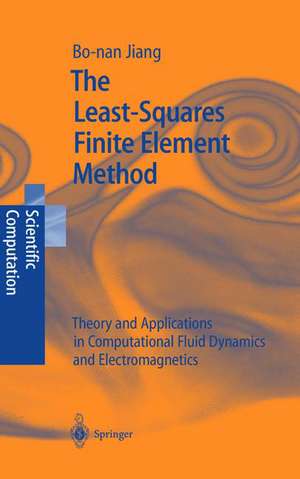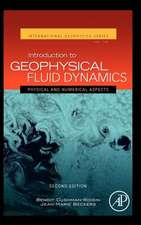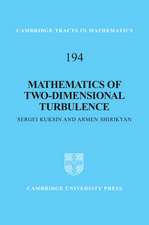The Least-Squares Finite Element Method: Theory and Applications in Computational Fluid Dynamics and Electromagnetics: Scientific Computation
Autor Bo-nan Jiangen Limba Engleză Hardback – 22 iun 1998
| Toate formatele și edițiile | Preț | Express |
|---|---|---|
| Paperback (1) | 951.14 lei 6-8 săpt. | |
| Springer Berlin, Heidelberg – 15 dec 2010 | 951.14 lei 6-8 săpt. | |
| Hardback (1) | 957.44 lei 6-8 săpt. | |
| Springer Berlin, Heidelberg – 22 iun 1998 | 957.44 lei 6-8 săpt. |
Din seria Scientific Computation
- 18%
 Preț: 1021.05 lei
Preț: 1021.05 lei - 18%
 Preț: 743.27 lei
Preț: 743.27 lei - 18%
 Preț: 889.75 lei
Preț: 889.75 lei - 18%
 Preț: 1108.51 lei
Preț: 1108.51 lei -
 Preț: 387.96 lei
Preț: 387.96 lei - 20%
 Preț: 902.04 lei
Preț: 902.04 lei -
 Preț: 400.85 lei
Preț: 400.85 lei -
 Preț: 386.61 lei
Preț: 386.61 lei - 15%
 Preț: 654.62 lei
Preț: 654.62 lei -
 Preț: 380.25 lei
Preț: 380.25 lei - 18%
 Preț: 1111.34 lei
Preț: 1111.34 lei -
 Preț: 452.62 lei
Preț: 452.62 lei -
 Preț: 389.31 lei
Preț: 389.31 lei - 18%
 Preț: 950.03 lei
Preț: 950.03 lei - 15%
 Preț: 649.22 lei
Preț: 649.22 lei - 18%
 Preț: 787.26 lei
Preț: 787.26 lei - 18%
 Preț: 942.63 lei
Preț: 942.63 lei - 15%
 Preț: 505.18 lei
Preț: 505.18 lei -
 Preț: 389.70 lei
Preț: 389.70 lei - 15%
 Preț: 653.00 lei
Preț: 653.00 lei - 15%
 Preț: 653.98 lei
Preț: 653.98 lei - 15%
 Preț: 643.99 lei
Preț: 643.99 lei - 15%
 Preț: 649.39 lei
Preț: 649.39 lei -
 Preț: 388.13 lei
Preț: 388.13 lei - 18%
 Preț: 958.38 lei
Preț: 958.38 lei - 18%
 Preț: 1129.52 lei
Preț: 1129.52 lei - 18%
 Preț: 967.56 lei
Preț: 967.56 lei - 15%
 Preț: 700.75 lei
Preț: 700.75 lei -
 Preț: 401.03 lei
Preț: 401.03 lei - 15%
 Preț: 597.99 lei
Preț: 597.99 lei -
 Preț: 385.62 lei
Preț: 385.62 lei -
 Preț: 394.87 lei
Preț: 394.87 lei -
 Preț: 385.08 lei
Preț: 385.08 lei - 18%
 Preț: 1106.63 lei
Preț: 1106.63 lei - 15%
 Preț: 504.17 lei
Preț: 504.17 lei - 15%
 Preț: 596.36 lei
Preț: 596.36 lei - 15%
 Preț: 653.98 lei
Preț: 653.98 lei
Preț: 957.44 lei
Preț vechi: 1167.61 lei
-18% Nou
Puncte Express: 1436
Preț estimativ în valută:
183.23€ • 190.59$ • 151.27£
183.23€ • 190.59$ • 151.27£
Carte tipărită la comandă
Livrare economică 15-29 aprilie
Preluare comenzi: 021 569.72.76
Specificații
ISBN-13: 9783540639343
ISBN-10: 3540639349
Pagini: 440
Ilustrații: XVI, 418 p.
Dimensiuni: 156 x 234 x 29 mm
Greutate: 0.79 kg
Ediția:1998
Editura: Springer Berlin, Heidelberg
Colecția Springer
Seria Scientific Computation
Locul publicării:Berlin, Heidelberg, Germany
ISBN-10: 3540639349
Pagini: 440
Ilustrații: XVI, 418 p.
Dimensiuni: 156 x 234 x 29 mm
Greutate: 0.79 kg
Ediția:1998
Editura: Springer Berlin, Heidelberg
Colecția Springer
Seria Scientific Computation
Locul publicării:Berlin, Heidelberg, Germany
Public țintă
ResearchCuprins
I. Basic Concepts of LSFEM.- 1. Introduction.- 2. First-Order Scalar Equation in One Dimension.- 3. First-Order System in One Dimension.- II. Fundamentals of LSFEM.- 4. Basis of LSFEM.- 5. Div—Curl System.- 6. Div—Curl—Grad System.- III. LSFEM in Fluid Dynamics.- 7. Inviscid Irrotational Flows.- 8. Incompressible Viscous Flows.- 9. Convective Transport.- 10. Incompressible Inviscid Rotational Flows.- 11. Low-Speed Compressible Viscous Flows.- 12. Two-Fluid Flows.- 13. High-Speed Compressible Flows.- IV. LSFEM in Electromagnetics.- 14. Electromagnetics.- V. Solution of Discrete Equations.- 15. The Element-by-Element Conjugate Gradient Method.- Appendices.- A. Operations on Vectors.- B. Green’s Formula.- C. Poincaré Inequality.- D. Lax—Milgram Theorem.- References.
Textul de pe ultima copertă
This is the first book devoted to the least-squares finite element method (LSFEM), which is a simple, efficient and robust technique for the numerical solution of partial differential equations. The book demonstrates that the LSFEM can solve a broad range of problems in fluid dynamics and electromagnetics with only one mathematical/computational formulation. The book shows that commonly adopted special treatments in computational fluid dynamics and computational electromagnetics, such as upwinding, numerical dissipation, staggered grid, non-equal-order elements, operator splitting and preconditioning, edge elements, vector potential, and so on, are unnecessary.
This book introduces the basic theory of the least-squares method for first-order PDE systems, particularly the div-curl system and the div-curl-grad system. It is applied to the study of permissible boundary conditions for the incompressible Navier--Stokes equations, to show that the divergence equations in the Maxwell equations are not redundant, and to derive equivalent second-order versions of the Navier--Stokes equations and the Maxwell equations. This book covers diverse applications such as incompressible viscous flows, rotational inviscid flows, low- or high-Mach-number compressible flows, two-fluid flows, convective flows, and scattering waves.
This book introduces the basic theory of the least-squares method for first-order PDE systems, particularly the div-curl system and the div-curl-grad system. It is applied to the study of permissible boundary conditions for the incompressible Navier--Stokes equations, to show that the divergence equations in the Maxwell equations are not redundant, and to derive equivalent second-order versions of the Navier--Stokes equations and the Maxwell equations. This book covers diverse applications such as incompressible viscous flows, rotational inviscid flows, low- or high-Mach-number compressible flows, two-fluid flows, convective flows, and scattering waves.
Caracteristici
This is the first monograph on the LSFEM method It treats Navier-Stokes and Maxwell equations in one and the same book














